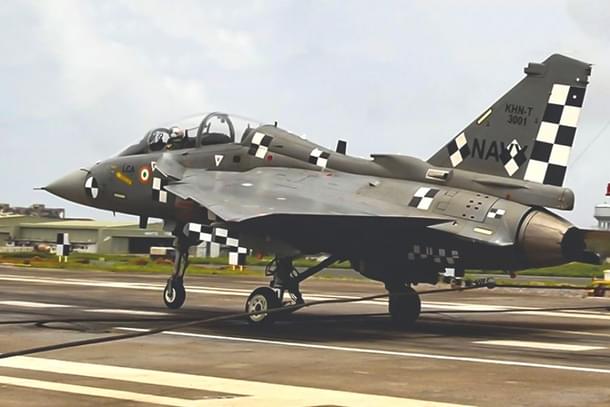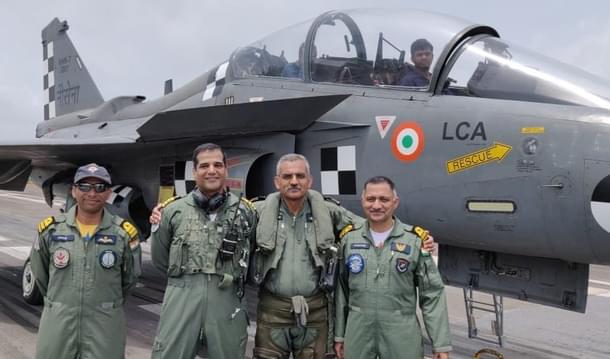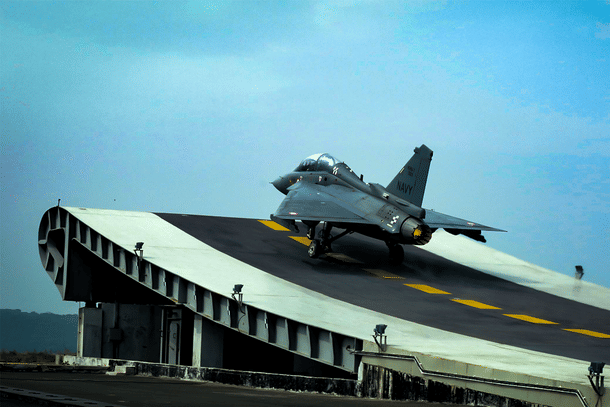Defence
Indian Navy’s Light Combat Aircraft: Love At First Trap!
K P Sanjeev Kumar
Sep 16, 2019, 07:47 PM | Updated 07:47 PM IST
Save & read from anywhere!
Bookmark stories for easy access on any device or the Swarajya app.


Recall the old proverb: ‘success has many fathers. Defeat is an orphan’. Nowhere does it ring as true as in aviation. Here, you are only as good as your last landing; even if it means you are ‘arrested’ upon landing.
On 13 September 2019, a typically wet, rain-washed morning at INS Hansa, a small group of engineers, scientists and flight test crew cheered as Mao (Commodore Jaideep Maolankar), experimental test pilot (ETP) from Indian Navy’s light combat aircraft (LCA) project office neatly trapped an arrester wire at the shore-based test facility (SBTF) in Goa.
The test point, an intermediate but significant milestone for which a small team toiled for years, was over in less than 3 seconds from touchdown. The momentum of LCA (Navy) touching down at over 130 knots was ‘arrested’ and brought to null in copybook naval fashion.
It built momentum for a new phase that will see action shift to a carrier deck soon. The tail-hook on LCA (Navy) and the arrester gear system at SBTF are stepping stones for Navy-ADA’s ambitious deck-based fighter programme.
Naysayers can now take a skin-dip in INS Hansa’s Spring Beach, a few miles off SBTF. The test point was repeated successfully very next day by naval ETP Captain Shivnath Dahiya, again with flawless precision. He described his moment as “truly a magnificent day; a lifetime experience”.
For flight test crew and designers, these few minutes provide reams of data for deep, scientific analyses. Out of that will emerge a tentative decision if the bird is ready to mate with its ultimate partner – the aircraft carrier?

The aircraft carrier is a gigantic, floating city of man, metal, combustibles, explosives and attitude. Here, there is no room for complacency or showmanship.
Team LCA (Navy)’s achievement, something that may soon culminate into a carrier landing, was 14 long years in the making, says ‘Mao’ with a clenched fist. He measures his words with the fortitude of a man who lost flag rank only to create history. It’s serendipitous that he reads a lot of fighter pilot John Boyd.
From a historical perspective, it is truly a landmark achievement for India and our naval aviation. We have been operating carriers for over half a century. But never has an indigenous fighter ever trapped an arrester wire on a carrier’s deck.
The carriers themselves have been imported and refurbished at great cost to exchequer.
The old era of short take-off but arrested recovery (STOBAR) aircraft made way for vertical and short take-off landing (VSTOL) sea harriers acquired with INS Viraat (now decommissioned). A crucial skill called ‘tail-hook landing’ was lost to the navy for over three decades till we procured INS Vikramaditya (former Russian carrier Gorshkov) and the MiG-29K.
Slowly, that skill was revived and caressed back to life. Today, naval MiG-29Ks routinely storm off VKD’s ski-jump with precision and elan. It hasn’t been easy or cheap. People have slogged through the graveyard shift. It’s time to acknowledge their contribution.
Only a rare breed of test crew has straddled the two worlds of STOBAR and VSTOL in India. Mao, Shiv and my colleague Theo (PDAWFS today) are among those few. So are people who have countered the case with stoic arguments. The counterweights are firmly in place. This augurs well for a service lost in translation between Russian carriers, American fighters and Indian attitude.
Interestingly, Rear Admiral Surendra Ahuja (retd), who now heads Boeing Defence’s India business, rekindled navy’s interest in tail-hook landings on the USN T-45C Goshawks while in service. His course-mate Mao has achieved the same on a fly-by-wire, unstable, indigenous, delta-wing planform.
I think it’s a great moment for naval aviation, worthy of all-round celebration.
Spend a moment to reflect on what it takes to achieve such a feat in a country where even traffic lights and seatbelts are seen as nuisance. Long gone are visionaries like Dr Kota Harinarayanana, the father of Indian LCA programme. His plain-speaking, cheerful guffaws, single-minded focus and gentle nudge propelled the LCA Navy programme to where it finds itself today.
Today, cross-pollinated scientists like Kota with a world view rooted in ground realities have been replaced by generalists, parochial minds and ‘babus’ who see ghosts and scams at every turn. An ‘import lobby’ feeds negative vibes into the system at every conceivable occasion. The lure of ‘proven products’ lining the shelves can be intimidating and coercive. It takes a certain ‘damn you’ attitude and ‘project ownership’ to fight against such daunting odds.
Fortunately, Indian Navy, in its wisdom, decided to humour the Maos while keeping the naysayers at yardarm distance.
If few careers were sacrificed at the altar of a national programme, so be it. That’s seagull-poop compared to what the small team invested with a crucial mandate delivered on 13 September 2019. We need to keep ‘arresting’ the metal birds while building greater mettle and momentum for future.
In days to come, this scene will shift to an aircraft carrier. We need good luck and godspeed; talent is covered. Most of all, we need an ecosystem that identifies right talent, gives them the right exposure and, if required, takes them off the career-carousel to an equally inspirational technical journey of discovery.

When rubber meets metal, it’s just another day at sea for naval aviation. That’s how it’s been and how it always should be. These are but stepping stones for breaking free of the chain-lashings that pin us down in subjugation to imports. If LCA (Navy) is allowed to soar, the possibilities are infinite in a country where raw talent is in abundance.
Perhaps this is also an apt occasion to highlight the peculiarities of naval requirements. The small team from Aeronautical Development Agency/Hindustan Aeronautics Limited/Defence Research and Development Organisation (ADA/HAL/DRDO) associated with LCA project knows best why navy needs special attention.
We are siblings with special requirements. Don’t hold it against us. It’s the way we are. Views coloured with hubris, or rose-tinted by idle romanticism — both must make way for synergy and define a common baseline for quality.
India is poised at a crucial juncture where different platforms — indigenous and imports — are mixed and matched in the name of ‘jointmanship’ and austerity. In this Russian roulette or American rodeo, navy runs a real risk of being left all dressed up with nowhere to go.
Many aviation watchers like me are elated that the LCA (Navy) came to an abrupt stop at Dabolim on 13 September 2019. Please stay the course, Team LCA (Navy). The best place to feather this momentum is ‘out of sea’.
I am waiting for that test point. December, let’s do this?
This article was first published on kaypius.com, and has been republished here with permission.
Capt K P Sanjeev Kumar is a former navy test pilot, now flying for offshore oil and gas. He has flown over 4,500 hours on 24 different types and holds a dual ATP rating on Bell 412 and AW139. ‘Kaypius’, as he is widely known in his circles, calls himself “full-time aviator, part-time writer”. He blogs at kaypius.com and tweets @realkaypius.





